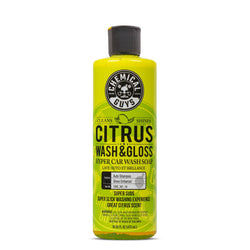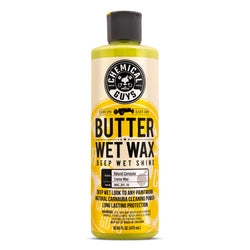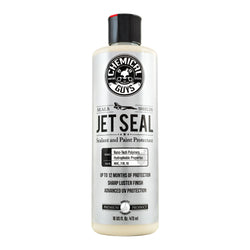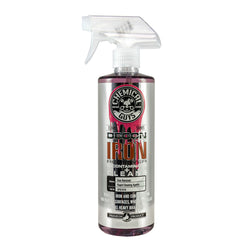| Exterior How-To's | |
| Interior How-To's | |
| Drying How-To's | |
| Latest Innovations | |
| Ceramic How-To's | |
| Detailing University |

When it comes to detailing, to some it may be as simple as a car wash, to others it can mean going the whole 9 yards and performing a thorough paint correction. The Chemical Guys detailing flow chart is designed to provide you with an outline of what steps to follow when it comes down to the procedure and layering your products.
Firstly, you will start off any detail with washing the vehicle. A wash can come in many different forms such as a deep clean, a full decontamination or just a maintenance wash.
Wash
- Deep Clean: A deep clean consists of a strong citrus based shampoo to break down heavy grime and contaminants..
- Decontamination Wash: A strip wash consists of using Clean Slate shampoo to remove all existing sealants or wax on the paint to completely rid the paint from all fillers, oils and protectants to get a raw finish. This is used as a prep for polishing or simply re-applying a fresh coat of products.
- Maintenance Wash: A routine method to maintain a coat of protection on the vehicle without stripping any existing coats of protection by using a pH neutral shampoo with gloss enhancers to maintain shine and durability of the protectant coat.
The decontamination process will cleanse your paint to remove every bit of contamination from your paint prior to following any other further steps in your detail to assure the best possible results.
Clay Bar/Chemical Decontamination
- Clay Bar: Remove embedded contamination on the paint by the use of a clay bar which is a sticky piece of clay that pulls of contaminants that are embedded into the pores of the paint.
- Chemical Decontamination: A light acid based cleaner such as Decon Iron Remover breaks down salt, rust, rail deposits and industrial fallout particle very deeply embedded in paint surface by chemically breaking it down and rinsing it off.
- After Manual and Chemical Decontamination (Optional): Wash the surface again to remove any leftover residue from clay luber or product which may have leaked into seals.
Now your paint is washed and prepped and you’re ready to move onto the next process of detailing your vehicle. This is where the detailing flowchart can go different routes depending on the condition of your paint or steps you want to take. Ideally this is the portion of the flowchart that deals with the condition of the paint in regards to if it’s in a good, moderate or poor condition which will determine if you have to polish or not. There are 3 different routes you can follow.
Paint Correction
- Good Paint: If you paint is in good or fair condition then you can simply skip the polishing process and jump straight into layering your protective products.
- Moderate Paint: If the paint isn’t in such great condition then you should polish your paint with a one-step swirl remover such as VSS or a cutting polish such as V36 with an Orange Hex-Logic Cutting Pad. If need be and you still have yet to refine the surface you can follow it up with V38 Final Polish and a White Hex-Logic Cutting Pad.
- Bad Paint: If your paint is in a bad condition where it’s oxidized or scratched and swirled up then you will need to perform a 2 step correction which consists of a cutting compound and a finishing polish. First use either V32 or V34 depending on how bad the paint is with an Orange Hex-Logic Cutting Pad to perform a heavy-medium cut to remove the deeper imperfections. Second, you want to follow it up with V36 Cutting Polish and a White Hex-Logic Polishing Pad to refine the surface, get rid of micro scratches left behind that the compound couldn’t remove and restore the shine of the finish.
Whether or not you had to polish to correct the paint, it is always ideal to wipe down the paint with a surface cleanser such as WipeOut. This removes any residual oils or product left behind on the paint to assure a completely clean and scratch free raw finish.
Surface Cleanser
- WipeOut: Gently mist WipeOut onto the surface and buff off with a Premium Microfiber Towel.
Next on the series of the flow chart, you have your protective coatings which can mean a number of different things possible depending on which products you wish to apply. Remember: this flowchart is to be used as an outline for layering your products properly. Some of the products you may not need to apply and/or may be optional products.
Protective Coatings
Usually referred to as a ceramic coating, which is a protective layer that goes on the paint to form a hard impermeable layer. It is also the longest lasting coating of protection available for paint. Therefore it lands this early on the flow chart because at this point your paint should already be cleaned, decontaminated, corrected and ready to apply your coating. The coating is applied first because the surface is prepped. When applied to the surface, it will deeply penetrate into the pores of the paint so it has the best bond possible.
Glaze
Glazes contain fillers and gloss enhancers which can condition and shine the foundation of your paint prior to applying any further layers of protectants. It is an excellent way to temporarily fill and hide light imperfections in the paint and condition the paint by giving it more depth and clarity if it has a dry/lightly oxidized look to it. Glazes are not necessarily considered a form of protection on the paint but they do utilize sealant properties which give the paint an anti-static and sleek feel. Make sure to apply a further coating of protection to lock in the layer of glaze in the paint to prolong its durability and shine.
Paint Sealant
A sealant is an artificial form of protection synthesized with advanced nano-tech polymers that create a very tightly bonded layer over the paint to repel incoming contaminants, water and UV rays from sticking to the surface. This is a form of long-term protection that utilizes aerospace technology to coat vehicles from daily driven contaminants such as dirt, grime, industrial fallout, and water spots from etching itself into or onto the finish. An application of sealant can last up to 12 months of protection and shine if maintained properly. It will also reflect prior coatings of products such as glaze or your protective coating if you decided to layer them.
Wax
Wax is a natural form of protection that derives from palm tree leaves that were once broken down and when refined leaves behind a natural oil that is either then converted to a liquid or paste wax. The natural oil from the carnauba wax coats the surface and the pores of the paint to reveal the shine from the paint and act as a layer of protection from UV rays and airborne contaminants from sticking. An application of wax onto a paint surface can last anywhere from 3-5 months if maintained properly. It will also enhance the look of the paint and any prior coats of glaze, sealant or protective coating.
Quick Detailer
A quick detailer is the perfect way to maintain all the work you’ve put into the paint. A quick detailer is a specially formulated lubricant designed to safely pull off light contaminants from your paint such as dust, fingerprints, bird droppings, industrial fallout and water drips after a wash. You can also maintain your paint by using a spray wax which is a quick and easy sprayable form of a carnauba wax to add a light coat of shine and protection right after a wash. Another alternative is a quick detailer/spray sealant which take both properties of a quick detailer and a sealant which adds a high shine and durable protection within an easy to spray and wipe formula.
As stated earlier, you do not have to do and apply every single step if not necessary or if following an alternate route. If you want to conduct a complete detail with all the steps above then follow them as outlined to achieve the best result possible. This article is just a basic foundation to base your detail off of to coordinate what result you’re going for, the products that you want to use and the work you want to put in. There are many steps and you may not be able to complete everything in one sitting if not properly prepared. No matter if you’re just planning for a simple wash, or a complete detail, this outline will guide you throughout the entire process.












